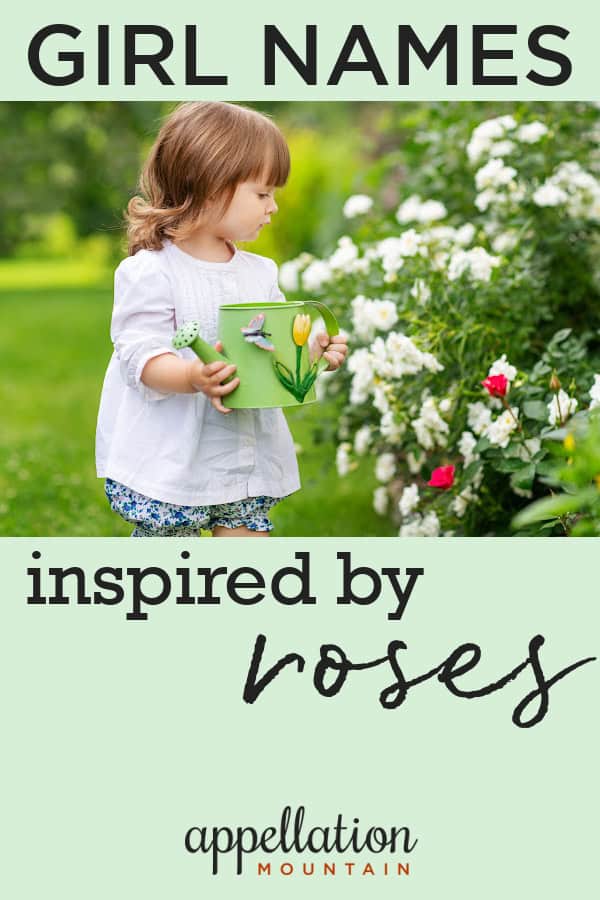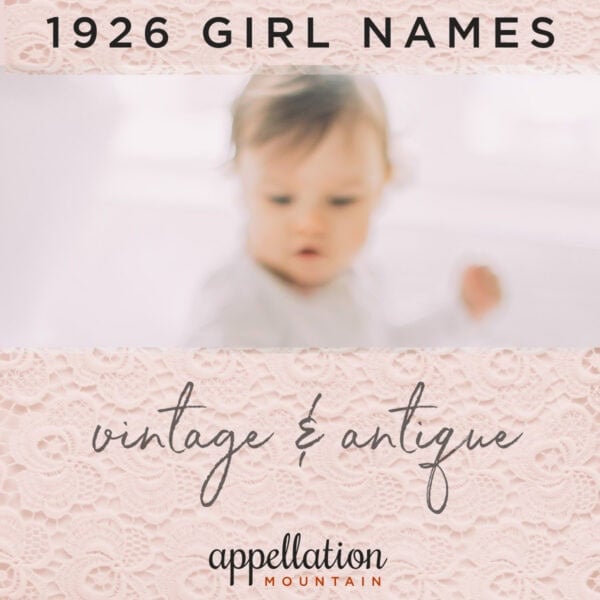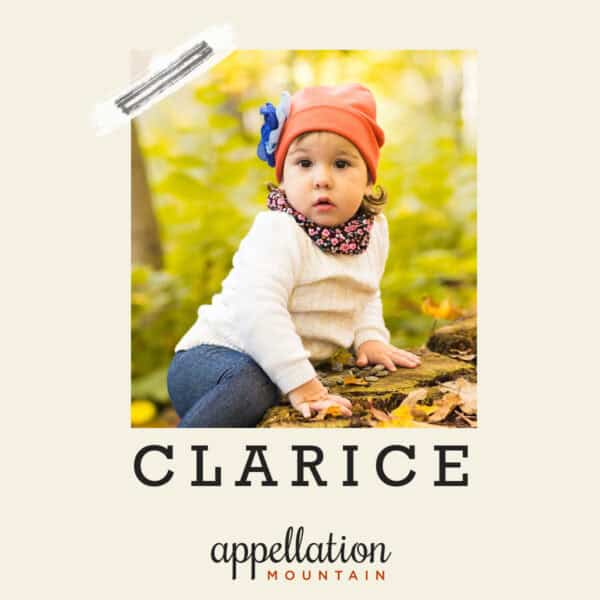Rose names range from the spare Rose, a classic with elegance and history galore, to elaborate and fanciful confections, from Harry Potter’s Rosmerta to Hunger Games’ Primrose. In mythology, they’re associated with the goddess of love, Aphrodite, among other stories and tales.
Of course, Rose reigns as the middle name of the moment. It pairs with time-tested baby names like Charlotte, as well as more modern baby girl favorites, like Everly or Eden.
But not so long ago, Rose stood proud as a first name favorite. A century ago, it regularly ranked in the US Top 20. Up until 1960, it appeared in the Top 100. As of 2024, the name stands at a respectable #115. But there’s still plenty of room for this lovely botanical choice to grow – and bring lots of other Rose names along for the ride.
In the botanical world, roses abound – there are well over 100 varieties. They come in every color. Rose names are equally plentiful, with dozens of possibilities. Some feel timeless; others lean literary; but every one of these Rose names has potential for a daughter born today.
CLASSIC (JUST) ROSE NAMES
ROSE
The timeless original. Like Jane or Grace, it’s a single-syllable choice that feels feminine, traditional, elegant, and strong. Equally suitable for a ballerina or a district attorney, Rose seems open to reinvention, a name that can suit nearly any child, and grow with any woman. With so many girls named Ava Rose, Mia Rose, and Olivia Rose these days, it’s often heard – though not often enough as a given name. Rose ranked #113 in 2020.
ROSA
The Latin version of the classic, Rosa seems at home in the Spanish- and Italian-speaking worlds, but it’s also heard throughout Europe. (Rosa is also used in Dutch, Danish, and Icelandic – to list just a few.) Civil rights icon Rosa Parks makes it a hero name. At #663 in 2024, it’s uncommon – but plenty familiar.
ROSIE, ROSY, ROSI
Rosie is the cheerful nickname for Rose, though it can also stand on its own. The spelling Rosie is most common as a name; while Rosy is more typically an adjective. Rosi is seen in some languages.
ROZA
This would be a very different choice, indeed, in English. But in Russian and several other Slavic languages, Roza-with-a-Z is familiar.
TRADITIONAL ROSE NAMES
ROSANNA, ROSEANNA, ROSEANNE
A Rose-Anna mash-up, Rosanna was the title of a smash hit song for Toto back in 1982. Not surprisingly, the name peaked in the 80s, too. Today it’s outside of the US Top 1000, along with Roseanna and Roseanne, as in Barr. That last one is almost certainly going to hibernate for a while. But Rosanna feels every bit as romantic and traditional as Isabella or Olivia. Besides Rosie, there’s also spunky nickname option Roxy.
ROSEMARY, ROSEMARIE
Hamlet’s Ophelia told us that Rosemary is for remembrance. It’s a softly vintage name, both a Rose-Mary smoosh and a borrowing from the herb, which was named from the Latin rosmarinus – dew of the sea. Plenty of songs feature the name. Romy is the German nickname, a fresh and vivacious spin on a gentle antique.
ROSAMOND, ROSAMUND
In use since the Middle Ages, this name has more in common with the equestrian-tinged Rosalind than the botanical Roses. Still, it’s tempting to translate this as “rose of the world” – in fact, the 12th century mistress of England’s King Henry II was named Rosamund Clifford and nicknamed precisely that. These Roses last appeared in the US Top 1000 in the 1930s, making them true throwbacks.
THE IMPORTS
RAISA
An Arabic or Russian name with separate roots, or a Yiddish equivalent of Rosa.
ROOS
The Dutch word for Rose, popular in the Netherlands now.
ROSALBA
Used mainly in Italian, this one means “white rose.” It has the romantic feel of Arabella, but remains far less expected. The name has never cracked the US Top 1000, and doesn’t seem especially common in Italy today, either. I’ve also found Rosalva listed on Spanish language name sites.
ROSAURA
A combination of Rose and the Latin word for golden, Rosaura was first used in a seventeenth century Spanish novel.
ROSARIA, ROSARIO
The term “rosary” literally translates to rose garden, but refers to a Catholic devotional prayer practice counted out on beads. Rosario is feminine in Spanish and masculine in Italian; Rosaria is the Italian feminine. Despite the success of actress Rosario Dawson and the lively sound of this name, neither version has recently charted in the US Top 1000.
ROSETTA
An Italian pet form of Rose, Rosetta is often followed by Stone – the ancient stele that provided the key to reading Egyptian hieroglyphics, as well as a widely-known language learning program. It was discovered in 1799 by the French, who had conquered Egypt under Napoleon the year before. The port city was called Rashid, but the French referred to it as Rosetta. It’s been out of the Top 1000 since the 1970s, but never say never to a comeback.
ROSETTE
It can be a sweet French diminutive for rose, though a Rosette is also a decorative element, either in fabric or architecture.
ROSETTI
A surname inspired by Rosetta that takes Rose names in the general direction of Harper and Avery. Poet Christina Rosetti makes this feel particularly wearable.
ROSWITHA
Not a Rose name at all, but a Germanic name that starts with the right sound.
ROISIN, ROSALEEN
In Irish, it’s spelled Róisín and pronounced ro sheen. It means “little rose.” Róis – rosh – is the literal translation for the flower. With authentically Gaelic names like Niamh and Saoirse on more parents’ shortlists, maybe Roisin’s moment is coming. So far, it’s never made the US Top 1000. A bonus? The name has patriotic and poetic associations, making it a worthy Irish heritage pick. It’s sometimes translated Rosaleen, which feels like it’s waiting with Darlene and Arlene for a future wave of revival.
RUZA, RUZENA, RUZICA
In languages like Czech and Croatian, Rosa becomes Ruza. Ruzena and Ruzica are elaborations of this Ru- rose.
LITERARY ROSES
PRIMROSE
Without the heroic Everdeen sister of Hunger Games fame, Primrose might feel too prim for a real girl. But the character transforms it from a botanical rarity to a more mainstream botanical option. It continues to gain steadily since the movie came out in 2012, though it’s yet to arrive in the Top 1000.
ROSALIE
In the 1920s, Rosalie was a princess in disguise in a Gershwin musical. In 1937, the musical became a movie and propelled Rosalie into the US Top 100. After several years out of favor, Rosalie is back again, thanks to another story adapted for the big screen – she’s Bella’s vampire sister-in-law in the Twilight franchise. Today the name stands at #198, a stylish sound that feels vintage and modern at once. (We do love a good three-syllable, ends-in-y name for a girl, don’t we? Some languages, like Czech, spell this name Rozalie.
ROSALIND, ROSALINE
Shakespeare used Rosalind for a character in As You Like It. Besides Rosie, Rosalind offers the nickname option Lindy, and might be a graceful way to honor women named Rose and Linda. It’s tempting to translate Rosalind as “beautiful rose,” but it comes from Germanic elements for horse – hros and soft – linde – meaning that the name suggests a biddable horse. Last big in the 1940s, Rosalind remains outside of the current Top 1000. A bonus? In Romeo and Juliet, Romeo was originally in love with another Capulet, Juliet’s cousin Rosaline.
ROSMERTA
The Harry Potter name was borrowed from an ancient fertility goddess. She’s the proprietress of The Three Broomsticks, Hogsmeade’s favorite watering hole.
VERED
There’s no rose in this name, but it’s a Hebrew word for the flower.
WARDA
An Arabic name meaning rose.
SMOOSHES & ELABORATIONS
ROSALIA, ROSELIA, ROZALIA
An ancient festival and the name of a twelfth century saint, Rosalia has history to spare, and a handful of spelling variants, including the Brazilian Portuguese Roselia and Polish/Romanian/Hungarian Rozalia.
ROSALINA, ROSALITA
Add -lina or -lita to Rosa, and you’ll have lovely elaborations of the original. Bruce Springsteen scored a hit with Rosalita in 1973.
ROSALYNN, ROSALYN, ROSLYN, ROSELYN
These might be a spin on Rosalind, or maybe they’re a Rose-Lynn smoosh. With Evelyn in the US Top Ten, these Rose names feel like options, too. One note: you might hear some of these pronounced Roz-lyn. Rosslyn, Virginia is part of metropolitan Washington DC.
ROSENA, ROSELLA, ROSELLE, ROSINA, ROSINE
Like Rosetta, these all started out as pet forms of Rose and Rosa, elaborations sometimes used as given names. Rosina appears in the Rossini opera The Barber of Seville. While none of them are trending, any of them might wear well today.
ROSABEL, ROSABELLE, ROSABELLA
Heard in romance languages, but rare in English, these are -bel names that fit right in with Annabelle and friends, but remain far less familiar.
ANNA ROSE, MARY ROSE, ELLA ROSE
Some might smoosh these together into Annarose, Maryrose, or Ellarose. But they work as double names, too, and that makes it tough to tell how common they’ve been over the years.
TYPES & VARIETIES of ROSES
ADELAIDE
Named for Adelaide d’Orleans, a French princess who spent many years in exile during the Revolution.
ALBERTINE
An award-winning rambling rose.
AMBER
A 1980s era hybrid, it’s full name is Amber Queen.
ANNELIESE
Also called the Oregold, this rose got its name from German opera singer Anneliese Rothenberger.
ANTIGONE
The Antigone is a hybrid tea rose first grown in France.
ANTONIA
A light pink rose that’s been around since at least the early 1800s, originally from France.
ARTHUR
Several types of roses are named Arthur, including a 1960s cultivar, named for whisky manufacturer Arthur Bell.
ASTRID
Several roses are named Astrid, including one honoring Swedish author Astrid Lindgren.
ATHENA
A popular rose, it’s white with pink edges.
AUDREY
Actress Audrey Hepburn was a life-long garden enthusiast, so it’s only natural that there’s a rose named for her.
BARBARA
Several roses are named Barbara, including ones honoring former First Lady Barbara Bush and legendary singer Barbara Streisand.
BENJAMIN
The Benjamin Britten rose honors the twentieth century composer and conductor by the name.
BETTY
Once again, multiple roses answer to Betty, including one named for the late comedienne Betty White. One of the floribunda roses, known for their many blooms, is named for cartoon character Betty Boop.
CATHERINE
This saintly, royal name appears in many a garden.
CECILE
A pink climbing rose, this flower was named after Cecile Brunner, daughter of Swiss grower Ulrich Brunner.
CELESTE
It’s also sometimes called the Celestial.
CHARLES
Multiple men by the name have been honored with roses, including Charles Dickens and Charles de Gaulle.
CHARLOTTE
Several roses bear this name, including one inspired by Armstrong Nurseries owner, John Armstrong. The Charlotte Armstrong was introduced in 1940.
CHRISTIAN
A French rose was named for design icon Christian Dior.
CLARISSA
A lovely miniature rose with an apricot color, one of many introduced by the UK’s Harkness & Co.
CLEOPATRA, CLIO
No surprise that there’s a Cleopatra rose. But there’s also one named for the Greek Muse, Clio.
CONSTANCE
A light pink rose, the Constance Spry was named for a gardening educator and author from the mid-1900s.
CORALIE
A coral-red rose from the early 1900s.
CORNELIA
An ancient Roman name for a vibrant pink rose.
COSIMO
A mauve rose from 1840s France, this one is named for Cosimo Ridolfi – an influential nineteenth century Italian.
DAISY
Of course, the daisy is a flower – but it’s also a given name. And the Daisy Hill is a rose dating to around the year 1900.
DARCEY
An English rose named for retired ballerina Darcy Bussell.
DIANA
Among many roses named for royals is the Diana, Princess of Wales rose.
DOLLY
A showy, orange-red flower, this rose is named for legendary singer Dolly Parton.
DOROTHY
There’s more than one rose bearing this traditional name, including the Dorothy Perkins, named for the granddaughter of famous rose-grower Charles Perkins.
EDEN
A popular name for a rose, used more than once across the years.
EDITH
There’s more than one Edith rose, including one named for legendary singer Edith Piaf.
ELIANE
Inspired by the French Eliane Gillet.
ELINA
A 1970s and 80s cultivar, Elina was developed by the Dickson family of Northern Ireland.
ELISABETH
Another spelling of classic Elizabeth, and popular with the roses, too.
ELIZABETH
Often inspired by the long-serving monarch, the late Queen Elizabeth II.
ELVIS
First introduced in France in 2008.
EMMA
Named for Lady Emma Hamilton, a fascinating figure from late 1700s Britain.
FERDINAND
The award-winning rose we know as the American Beauty started out as the Madame Ferdinand Jamin. There’s also the Ferdinand Pichard, which has been around since the 1920s. (The latter is found in Martha Stewart’s rose garden.)
FLORENCE
Florence sounds like a natural name for a rose. One famous variety honors the world-changing nurse, Florence Nightingale.
FRANCES, FRANCIS
There’s a rose named the Francis Meilland after a legendary French horticulturalist, and another named Sweet Frances, apparently named in a contest.
FREDDIE, FREDERIC
Roses have been named after musicians as diverse as Queen’s Freddie Mercury and the composer Frederic Chopin.
FRITZ
A handful of roses have been named after this Friedrich nickname, all originating in Germany.
GEORGE
At least one rose is named George, as in the George Best, inspired by the legendary Irish footballer.
GINGER
There’s a hybrid tea rose named for dancer Ginger Rogers, an Oscar winner during Hollywood’s Golden Age.
GRACE
More than one rose is called Grace, including one also called the Princesse de Monaco, for the late Grace Kelly.
HARLOW
A new variety of English rose is known as the Harlow Carr. It’s named for a public garden operated by the Royal Horticultural Society in the UK.
HEIDI
Supermodel and entrepreneur Heidi Klum has this German variety of rose named for her.
HELEN, HELENE
Roses are named both Helen and Helene, including one named after actress Helen Hayes, the “First Lady of American Theater.”
HENRI, HENRY
French artist Henri Matisse has a bloom named for him; so does explorer Henry Hudson.
HONORINE
A lovely striped rose, apparently named for a noblewoman.
INGRID
As in iconic actress Ingrid Bergman.
LAURA
The name of a classic, bright pink rose, or there’s the Laura Ford, a yellow climbing rose.
LOUISE
The Princess Louise rose dates to the early 1800s.
LUCY
The Blushing Lucy rose puts this name on the list.
MARINA
Developed in the 1970s, the Marina rose comes from Germany.
MCCARTNEY
Named for legendary musician Paul McCartney.
OCTAVIA
A tribute to social reformer Octavia Hill, one of the co-founders of England’s National Trust.
PATRICK
Plenty of roses are named for saints, like the yellow St. Patrick rose.
PENELOPE
There’s an English rose called the Penny Lane and another named Penelope.
PRUDENCE
The “Dear Prudence” rose is clearly a callback to the Beatles’ song.
SALLY
Another Hall of Fame rose, the Sally Holmes was named for the wife of creator Robert Holmes.
SYLVIE
Named for singer Sylvie Vartan.
TESS
One of the English climbers, this rose is named for the novel Tess of the d’Urbervilles.
VICTORIA
Roses named for monarchs are plentiful. More than one is naming for the long-reigning Queen Victoria.
WILL, WILLIAM
Several cultivars share this name, including at least two named for William Shakespeare and one named for Robin Hood companion Will Scarlet. (Of course the petals in that last one? They’re a vivid shade of red.)
ZORINA
Named for German-Norwegian ballerina-turned-actress Vera Zorina.
There you have it – plenty of reasons to rescue Rose from the middle spot and promote it to first, along with some rare, Rose-inspired picks.
What are your favorite Rose names?
Originally published on July 30, 2008; this post was revised on May 7, 2012; January 17, 2014; June 4, 2018; June 5, 2020; October 22, 2020; May 21, 2021; February 9. 2023; and July 31, 2025.





A favorite rose is the Julia Child rose, a golden floribunda rose. I’ve also discovered that there are roses with my mother’s name, my daughters’ names, and my name!
I think Roselle is a beautiful name!
Rosabella
Hi! As a Rose (Rosemary) I was called so many different names as well. I got Rosie, Flower, Rosey posey, and so much more. I also got Vanessa ( No idea where that came from. Most likely how Catherine came in) . I grew up HATING my name and now I am 23 years old, and planning my future family and I have learned to love my old name and I want to name my daughter Rosaline. Your daughter will grow to appreciate the old lady name! <#
My daughter’s name is Autumn-Roses. We call her Roses! Only problem is that people only hear what is normal, so I’ll say her name is Roses and everyone automatically thinks Rose. But she is our bouquet
I see I’ve commented on this post twice, in earlier years. Here’s my update now that my Rose is 15:
I still love her name and think it was a great choice.
In 5th grade she was in a split class with the grade above. That put her in a class with a Rosa and a Rosie. She didn’t mind, but I thought that was pretty crazy.
In middle school some kids nicknamed her “Flower”. She didn’t like that. Also middle school is weird with one kid saying that she looked like a Catherine (or some other name) and then other kids thought that was her name because the one kid called her that. So they were surprised to hear that her name was actually Rose.
She doesn’t appreciate having “an old lady” name and plans to name her own children with non-old-people names one day.
How about the beautiful Welsh Rhoswen? Nicknames could be Rosie or Winnie
You left out my daughter’s favorite (for over 5 years now– she’s 7…):
Rosalina
Great article! We almost went with my grandmother’s full name for our daughter, Clara Raisa (Raisa being “Rose” in Yiddish…and maybe some Slavic languages as well?), but changed it at the last minute. I still love the name Raisa, though.